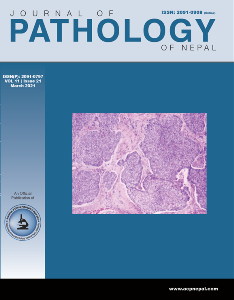Cyclin D1 expression and its correlation with clinicopathological variables in colorectal carcinoma
DOI:
https://doi.org/10.3126/jpn.v11i1.29291Keywords:
Adenocarcinoma; Colorectal carcinoma; Cyclin D1Abstract
Background: This study was conducted to evaluate the expression of Cyclin D1 in colorectal carcinoma, and to correlate Cyclin D1 positivity with the grade of the tumor along with other parameters such as age, tumor location, lymph node metastasis, and vessel invasion.
Materials and Methods: The present cross-sectional study was conducted on 40 proven cases of colorectal carcinoma from October 2015 to October 2017. The tissues were fixed, processed, and stained with hematoxylin and eosin followed by immunohistochemical staining with Cyclin D1 using monoclonal antibodies.
Results: 75% of the cases were conventional adenocarcinoma while the rest were mucinous adenocarcinoma. Of the total colorectal carcinomas,12.5% were Grade I, 50% were Grade II and 37.5% cases were Grade III. Cyclin D1 positivity was seen in 60% of cases with the most positivity in grade II tumors. A statistically significant correlation of Cyclin D1 was seen with age group (5th- 6th decade) and histological type of tumor. No significant correlation was seen of Cyclin D1 with lymph node involvement, depth of invasion, vascular invasion, or perineural invasion. A significant statistical correlation was seen with Crohn’s-like reaction and peritumoral lymphocytic response.
Conclusions: Thus, it was concluded that a highly statistically significant correlation was seen with age group (5th- 6th decade) and histological type of tumor. No significant correlation was seen with Cyclin D1 expression with lymph node involvement, depth of invasion, vascular invasion, or perineural invasion.
Downloads
Downloads
Published
How to Cite
Issue
Section
License
This license enables reusers to distribute, remix, adapt, and build upon the material in any medium or format, so long as attribution is given to the creator. The license allows for commercial use.




